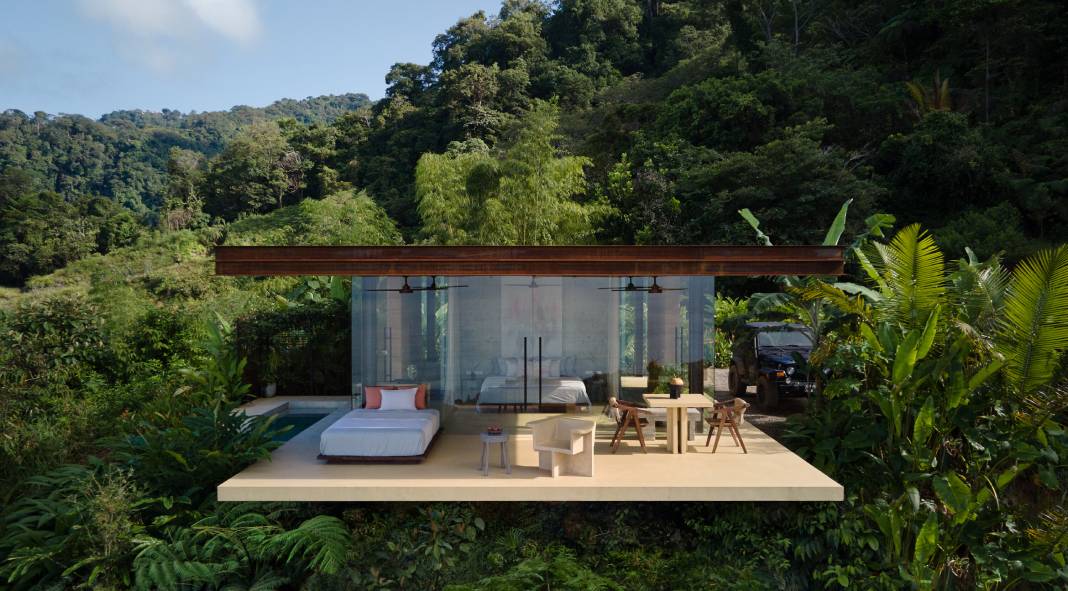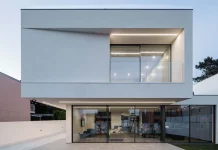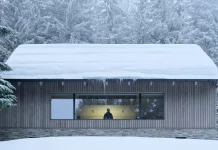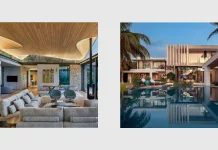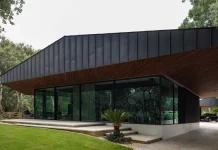Dagmar Štěpánová of Formafatal completely used clay soil from the excavations for the construction of all perimeter-bearing walls of this architectural masterpiece.
Formafatal‘s Dagmar Štěpánová has created two unique villas, located on a lush 11,000 square meter hilltop overlooking Uvita town – 300 meters above sea level. Each villa is 90 m2 in size and appears to levitate upon the steep southern slope; they are intended for short-term vacation rentals. This extraordinary design brings together nature and modern architecture as one!
Dagmar Štěpánová had the ambitious vision of constructing eco-friendly abodes with biophilic interior designs that are just as sophisticated and minimalistic in their aesthetics. She strived to create interiors where no unnecessary elements would be present but nothing essential was ever left out either.
The deliberate thin and sharp lines of villa architecture contrast with the lush tropical vegetation, yet the materials and colors chosen are in perfect harmony with their environment.
Despite having the same architectural designs, materials used, and cardinal orientation points for both villas, their interiors differ substantially. This is further amplified in the exteriors by way of various color concepts used to complement both living spaces. Please read more below the following images.

The design of the architecture is based on the genius loci – specifically, its location in relation to a magnificent view of the Pacific Ocean and how it’s nestled within its terrain. The color scheme showcased throughout each villa responds to energies felt before construction began; while they may only be 12 m apart, these villas possess individual vibrancy that was captured by their interior decoration.
Jaspis Villa, named after jasper which reflects bright light, is a haven of peaceful yin energy. It echoes the harmony between ocean and sky within its walls and vibrations. To underline this connection with nature, designer Dagmar Štěpánová chose warm shades of sand for the color concept. On the other hand, Nefrit Villa (named after Jade), exudes bold yang energies while connecting guests to their surroundings — jungle and soil alike — through terracotta-colored concrete floors that mimic local clay tones in its design.
Upon entering, the villas appear to be unassuming and modest. However, as you make your way through them, towards the elevated terrace area after a few steps you will witness an exquisite view of the ocean which stretches before you. Further on into this picturesque scene is found a luxurious main bedroom with accompanying verandas and an infinity plunge pool. You could almost feel like have stepped out of one villa while still being in another!
Dagmar Štěpánová highly prioritized the significance of all construction and architectural nuances, in addition to their interactions.
The breathtaking rammed earth walls and concrete structure are accentuated by the strong steel H-beams, which bear a monolithic ceiling slab. The house’s girders and ring beam can only be seen in the roof’s upper face, covered with two striking “U” profiles that also offer additional attic storage space.
Both villas are designed to offer stunning views of the ocean through their frameless glass facades. These are recessed within grooves in the concrete ceiling slab, allowing for interior lighting rails and connecting rail systems for mosquito nets and curtains around the bed. The flooring is a unique non-slip structure created with cement screed that differs between each villa. Besides the solid concrete furniture, the interior walls are coated with a matte cement screed for a sleek and smooth finish.
To ensure that the house would be able to withstand the humid climate of Costa Rica, the architect made sure to choose only the most durable materials available. As no one in Costa Rica had any experience with Rammed Earth construction, Dagmar Štěpánová invited Daniel Mantovani from Brazil’s Terra Compacta company who then trained several local craftsmen on this particular method. And it is thanks to their efforts and expertise that they can proudly claim first prize for achieving successful Rammed Earth architecture in Costa Rica!
Minimalist architecture is highlighted in the interior design too, with a large-format sliding panel acting as the only door to section off parts of the shower and toilet area. Moreover, it also serves as a wall hanger for a mirror! Custom-made furniture pieces such as kitchen desks, sinks, shelves, solo bedside tables, or benches are all made from concrete—surely bringing out your personal style while exuding an air of sophistication. When crafting the concrete solitaires, the architect found inspiration in Bram Vander-Beke’s work. He also sought unique furniture, lights, decorations, and art from all corners of the world to adorn this space. Everything was chosen with an eye for originality and excellence!
All images © by Dagmar Štěpánová of Formafatal. Do not hesitate to browse through the Architecture and Interior Design categories on WE AND THE COLOR for more inspiring projects from all over the world.
Subscribe to our newsletter!

